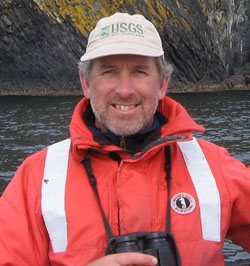Campus News
Recovery slows for California’s sea otters, 2012 survey shows
The southern sea otter population continues its pattern of tepid recovery, according to the latest population survey.


The southern sea otter population continues its pattern of tepid recovery, according to the latest population survey led by scientists with the U.S. Geological Survey, UC Santa Cruz, and the California Department of Fish and Game.
Since the 1980s, USGS scientists have calculated an averaged population index each year for the southern sea otter, a federally listed threatened species found in California. The population index is typically calculated as multiple-year averages of raw data from annual surveys, to compensate for year-to-year variability in observation conditions and to give scientists a more reliable picture of sea otter abundance trends. For the 2012 report, USGS lists the population index as 2,792. The survey data are now available online.
After nearly a decade of slow recovery in California sea otter numbers, the population index indicated a stall in 2008 and a decline to 2,711 in 2010. Even though the 2012 numbers are a comparative increase from those 2010 figures, the longer-term trend suggests that the population recovery may be at a plateau.
“We saw a similar plateau in the late 1990s, before sea otter numbers began to rise again in the early 2000s,” said Tim Tinker, a biologist with UC Santa Cruz and the USGS Western Ecological Research Center, who supervises the annual survey. “Recent shifts in mortality causes have brought to light additional explanations for the cessation of growth we’ve seen over the last few years.”
USGS scientists recently updated their database of sea otter strandings–the number of dead, sick or injured sea otters recovered along California’s coast each year. The numbers are available online.
In 2011, scientists from CDFG, USGS, UCSC, Monterey Bay Aquarium and other institutions came across a total of 335 stranded sea otters, a record high. Efforts are made to recover and examine each reported sea otter carcass, and a subset of fresh carcasses are sent to the CDFG Marine Wildlife Veterinary Care and Research Center, where veterinarians conduct necropsies to determine the primary causes of death and identify factors that may have contributed to the death of each animal.
“We saw an increase in death due to white shark ‘tasting’ bites,” said Melissa Miller, the necropsy veterinarian at the CDFG center. “We are working closely with our collaborators to understand what could be driving this new trend. The usual causes of deaths were also evident: harmful algal toxins, parasites and infectious diseases, mating trauma, emaciation, bacterial infections, heart disease and boat strikes round out the list.”
According to Tinker, the continued lack of population growth in the center of the geographic range–where sea otter densities are highest–adds evidence that sea otter populations may be approaching equilibrium abundance in these long-established areas. “The population density of sea otters is ultimately limited by their prey resources, although reduced food abundance may act in concert with other factors, such as infectious diseases,” says Tinker.
“With natural factors like the shark bites and food limitation, there’s little we can or should do,” said Lilian Carswell, Southern Sea Otter Recovery Coordinator for the U.S. Fish and Wildlife Service. “But to cope with non-natural factors, the population recovery at the very least will depend on sea otters expanding into new areas that can support sustained populations.”
For southern sea otters to be considered for removal from threatened species listing, the population index would have to exceed 3,090 for three consecutive years, according to the threshold established under the Southern Sea Otter Recovery Plan by the U.S. Fish and Wildlife Service. That would mark a significant comeback for this marine mammal, presumed extinct in California after the fur trade years until a population of less than 50 animals was discovered off the coast of Big Sur in the 1930s.
Sea otters are considered a keystone species of the kelp ecosystem, preying on herbivorous invertebrates that can decimate kelp beds and subsequently fish habitat, if left unchecked. Scientists also study sea otters as an indicator of nearshore ecosystem health, since sea otters feed and live near the coast and often are the first predators exposed to pollutants and pathogens washed down from coastlands, such as the microbial toxin microcystin.
“Just as the polar bear has become symbolic of protecting the Arctic, so is the status of the sea otter emblematic of the health of the Central California Coast,” said USGS Director Marcia McNutt. “These annual surveys and the associated studies to understand the drivers for population changes are critical factors in ensuring the continuing survival of not just the sea otter, but the entire complex ecosystem for which this icon is integral.”
Survey Methodology
The annual population index is calculated from visual surveys conducted along the California coastline by researchers, students and volunteers from USGS, CDFG’s Office of Spill Prevention and Response, Monterey Bay Aquarium, Santa Barbara Zoo, UC Santa Cruz, U.S. Fish and Wildlife Service, and U.S. Bureau of Ocean Energy Management.
Surveys are conducted via telescope observations from shore and via low-flying aircraft, typically from April through June. This year, the surveyed coastline spanned Point San Pedro in San Mateo County south to Rincon Point near the Santa Barbara/Ventura County line.
The annual survey was interrupted in 2011, when weather conditions prevented the survey completion.